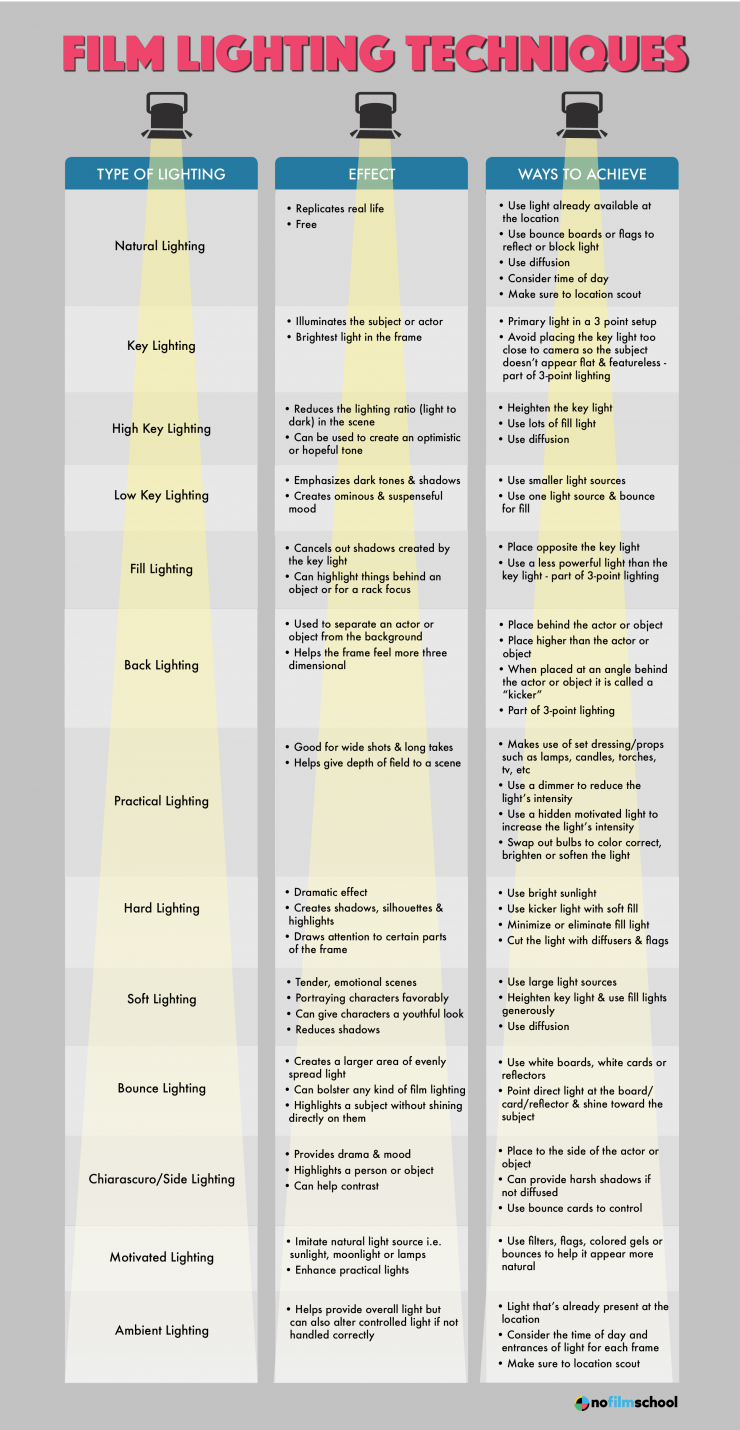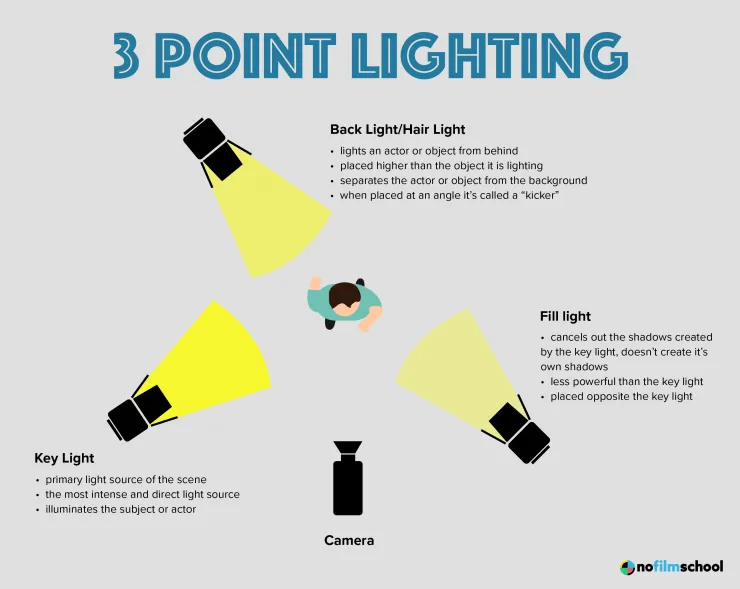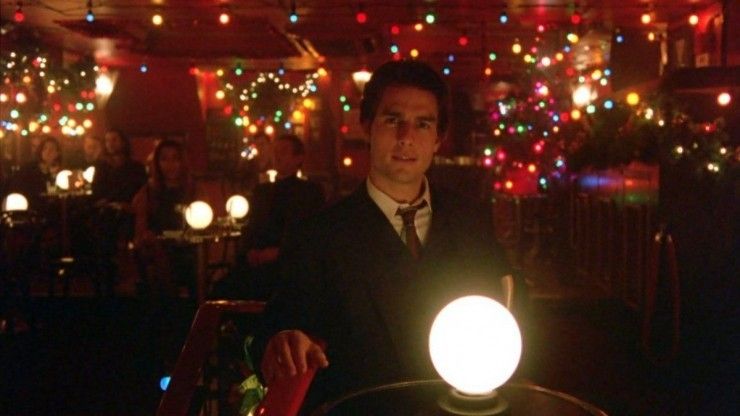
Film lighting techniques make your commercial, movie, or TV show look cinematic. It will help your story pop off the screen. We break down every major technique.
Lighting techniques are invaluable for filmmakers at every level. For a director, they can help you communicate with your cinematographer. For a writer, they can help you craft words on the page that set the tone, and for the rest of the jobs on set, you'll spend most of your time waiting for everyone to get the film lighting right. So don't you want to know some lighting techniques so you can help out?
Here at No Film School, we're always trying to create handy guides to help beginning and experienced filmmakers achieve the look and feel they want for their projects. We've talked about types of film lights before and deconstructed lighting at every level, including specific tips for black and white. But today we're going to take you through some basic lighting techniques that can help you make your work look and feel more cinematic, no matter what aspect ratio you shoot in. And after this if you want to dive into some more directing skillsets, check out the art of blocking!
So let's fire up those bulbs and take it from the top!
Table of Contents

13 Film Lighting Techniques
1. Natural Lighting
First up, let's look at lights we don't have to move. They move every hour of the day. Natural film lighting techniques are defined by utilizing the light that is already available at whatever location you choose. Most times, you head out on a location scout before you shoot and have that information. You also should think about the time of day you're at those locations.
Natural lighting summary
- Use bounce cards or flags to alter natural light
- Make sure you do a location scout
- Take time of day into account

2. Key lighting
A key light is the primary light source of the scene. It is the most intense and direct light source. Generally, the key light will illuminate the form of the subject or actor.
Key light summary:
- Avoid placing your key light near the camera or your light will become flat and featureless.
- Create a dramatic mood by using the key behind the subject
- A key light is the primary light in a three-point lighting setup.

3. High Key Lighting
The definition of high key lighting is a style of lighting for film, television, or photography that reduces the lighting ratio in the scene. In the first days of film, this was done to deal with high contrast, but now it's used by filmmakers to adjust the mood and tone of a scene.
High key lighting summary:
- Dominated by white tones from bright lights
- Minimal use of blacks and mid-range tones
- Tone can be optimistic or hopeful
- Used in a lot of pop music video lighting setups

4. Low Key Lighting
What is Low Key Lighting? The definition of low key lighting is a filmic lighting style that uses a hard source to encase your scene in shadow. Low key lighting wants contrast and blackness.
Low key lighting summary:
- Dark tones, blacks, shadows
- Striking contrast images
- Used in noir or thrillers for ominous warnings

4. Fill Lighting
What is a Fill Light? A fill light cancels out the shadows created by the key light. A fill light is placed on the opposite of the key light, and usually not as powerful as the key.
Fill Light Summary:
- Remove shadows created by the key,
- Does not create shadows or it’s own characteristics.

The Three-Point lighting setup
The key light, backlight, and fill light all make up the three-point lighting setup. Three-point lighting is a standard method used in visual media. By using three separate positions, the cinematographer can illuminate the subject any way they want, while also controlling shadows produced by direct lighting.

5. Backlighting
What is Backlight? A backlight hits an actor or object from behind. It is placed higher than the object it is lighting. Backlights are used to separate an object or an actor from a background. They give more shape and depth. Backlights help the frame feel three-dimensional.
Backlight Summary:
- The sun is a great backlight - you can use a reflector or bounce the sun at a lesser intensity back the subject.
- If a backlight is placed behind an actor at an angle, the backlight is called a "kicker."

6. Practical Light
What if you want to use light sources within a location? Things like lamps, candles, or even the television set? We call those things practical lights. Most of these accouterments are added to the set to light corners or faces by set designers anyone from the lighting crew to help the ambiance.
Practical light summary:
- Consider multiple practical lights to help illuminate a subject
- Keep a count of available outlets in every location
- Make sure color temperatures match

7. Hard Lighting
Hard light is a harsh souring of light that can be created with a direct beam from a light source or from the sunlight. This kind of lighting creates shadows and harsh lines. You can use it to draw attention anywhere in the frame, especially on the subject. It can also create silhouettes and highlights.
Hard lighting summary:
- Can be stopped with diffusers or flags
- Will highlight anything in the frame
- Great for shadows

8. Soft Light
This one is tricky. Soft lighting is not a strict definition of a light source. Soft lighting is an aesthetic used by cinematographers to eliminate shadows and to recreate subtle shades of light from exterior sources.
Soft lighting summary:
- It can be used as a fill light
- It can add youth to a subject's face
- Gives the illusion of coming from practical sources

9. Bounce Lighting
Got a whiteboard or white card? You can bounce light from the sun, lamps, or any film lighting kit to indirectly highlight a subject within the frame. Using a bounce light creates a larger area of evenly spread light. If executed in the right way bounce lights can be used to create a much soft light, fill light, top, side, or even backlighting.
Bounce light summary:
- Can be used to bolster any kind of film lighting
- Created by pointing direct light and bouncing indirectly
- Highlights a subject without directly shining on them

10. Side Lighting or Chiaroscuro Lighting
Much like the name, side lighting refers to light that enters the frame from the side to highlight a person or object. These parallel lights provide a faint fill. They're often used to provide drama and mood to a scene, particularly in the genre of film noir. Many people refer to side lighting as "chiaroscuro" lighting as well. To achieve chiaroscuro lighting, you need a strong contrast and low-key to accentuate the contours of your subject. If your side light is used to fill a scene you may need to bounce it or deal with high-key effects.
Side lighting summary:
- Used to highlight a person or object
- Can possibly provide harsh shadows if not diffused
- Can help in contrast

12. Motivated Lighting
Let's say you're on set and can't find any natural light sources. That's where motivated lighting comes into play. Motivated lighting is a technique that seeks to imitate natural light sources. That means it's a stand-in for sunlight, moonlight, street lights, and even car headlights. You can use flags or bounces to help create them and alter them to appear natural.
Motivated lighting summary:
- Used to mimic natural elements
- Can be altered with any tools or set dressing

13. Ambient Light
Unless you're shooting in a pitch black night or an artificial space, there will always be some sunlight or lamplight or overhead light that seeps in. This light that's present is known as ambient light. You need to account for ambient light, especially when shooting outside or near windows. As the time of day changes, ambient light changes, so think about that when shooting one scene over a long period of time.
Ambient lighting summary:
- Always take into account the time of day
- Refers to light that leaks into frame

What's next? Learn all the types of film lights!
Your film lighting matters in every shot. It can help you set the tone, look professional, and create the atmosphere of your story. We've deconstructed lighting on No Film School before, but today we want to aggregate all the ideas and techniques behind picking a lighting scheme for your film. These are video lighting setups and film lighting setups that are crucial to storytelling.
Of course, you can always dig more by learning about lighting ratio and light sources. Also, be sure to check out our complete guide to camera angles. If you've mastered all of that, check out our DIY tutorial on using split diopters!
If you want to do more off-the internet reading, check out this list of the best 25 cinematography books.
Your Comment
5 Comments
Man(expletive), I like this article, getting/fixing/messing with the lighting, ( for a movie/clip) is like fixing a well deserved omelet after a hard mornings work out, for a white boy-Jewish, like myself.
May 13, 2019 at 9:43AM
We (all) tend to use so many of these techniques whether we realize it or not. Many of us do so by nature and/or experience over the years, including tips we find along the way. This summary adds a "face to the name" and that is of value. Thank you.
May 13, 2019 at 10:29AM
Very helpful information for the budding cinematographer. Personally, I'm a big fan of practicals and motivated light. I highly recommend reading the book, Masters of Light.
I have recently put together a cinematography quote post that I think your readers would appreciate. The post contains over 150 quotes and lessons from the greatest cinematographers of all-time and covers everything from how to light to career advice and finding film projects.
photogpedia.com/the-best-cinematography-quotes/
As far as I'm aware, it's the most comprehensive list of cinematography quotes available on the internet and definitely something that your readers will find helpful.
Anyway, keep up the great work on No Film School.
October 24, 2020 at 7:14AM, Edited October 24, 7:17AM
MISTAKES
• There are two number 4s - doh
• The picture for fill lighting doesn't HAVE a fill fill light. It's just a key + backlight. Doh.
December 10, 2021 at 12:44PM
And 10 is hardly 'chiascuro' – DOH!
December 10, 2021 at 12:45PM